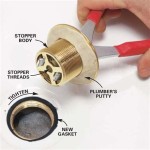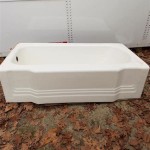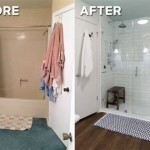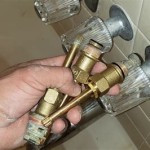How To Get Out Of The Bathtub After Knee Replacement Surgery in Massachusetts
Recovering from knee replacement surgery, a common procedure performed in Massachusetts and elsewhere, presents various challenges. One seemingly simple, yet potentially difficult task is safely exiting the bathtub. The decreased mobility, pain, and balance issues that often accompany recovery necessitate careful planning and execution. This article provides a detailed guide on how to safely get out of the bathtub following knee replacement surgery, with a focus on minimizing risk and promoting a smooth recovery process.
Before attempting to get out of the bathtub, consider the overall setup of the bathroom. A slippery surface combined with limited range of motion can create a hazardous environment. Therefore, proper preparation and the use of assistive devices are crucial. Consulting with a physical therapist in Massachusetts for personalized guidance is highly recommended. They can assess individual needs and provide tailored recommendations based on the specific procedure and recovery progress.
Assessing the Bathroom Environment and Necessary Equipment
The first step involves critically evaluating the bathroom for potential hazards. This begins with the bathtub itself. Is the tub deep, requiring a significant step to enter and exit? Is the surface slippery? Are there readily available grab bars or other supportive structures? Answering these questions will inform the selection of appropriate assistive devices and the modification of the existing environment to maximize safety.
Consider the floor surrounding the bathtub. Is it prone to becoming slippery when wet? Placing non-slip mats both inside and outside the tub is essential. These mats provide added traction and reduce the risk of slipping, a major concern for individuals recovering from knee replacement surgery. Ensure the mats are securely placed and do not have curled edges that could create a tripping hazard.
Grab bars are invaluable aids for maintaining balance and providing support during the transfer process. If grab bars are not already installed, consider having them professionally installed. Placement is critical: typically, one grab bar should be positioned vertically near the faucet and another horizontally along the side wall of the tub. These bars provide points of leverage for pulling oneself up and maintaining stability.
A bath seat or transfer bench can significantly ease the process of getting in and out of the tub. A bath seat is placed inside the tub and allows the individual to sit while showering or bathing, reducing the need to stand for extended periods. A transfer bench spans the side of the tub, allowing the individual to sit on the bench outside the tub and then slide over into the tub, minimizing the distance required to step. The choice between a bath seat and a transfer bench depends on individual needs and abilities, which is something to be discussed with a healthcare professional.
Having a long-handled sponge or shower brush can also be beneficial. These tools allow for cleaning the lower extremities without excessive bending or twisting, which can put strain on the healing knee. Similarly, a handheld shower head provides more control over the water stream, making rinsing easier and reducing the need to move around excessively.
Furthermore, keep a towel readily accessible and within easy reach. Drying off immediately after exiting the tub is important to prevent chilling and to further reduce the risk of slipping on a wet floor. Having someone present to assist, especially in the initial stages of recovery, is highly recommended. This individual can provide physical support, emotional reassurance, and monitor for any signs of dizziness or instability.
Finally, clear the surrounding area of any obstacles that could impede movement. This includes items such as bath mats, laundry baskets, or toiletries. Creating a clear and uncluttered path will minimize the risk of tripping or stumbling during the transfer process.
Step-by-Step Guide to Exiting the Bathtub Safely
Once the bathroom environment has been assessed and the necessary equipment is in place, the next step is to follow a safe and methodical approach to exiting the bathtub. This involves breaking down the process into manageable steps and focusing on maintaining balance and stability throughout.
Begin by turning off the water and allowing the water to drain completely. This will reduce the risk of slipping on standing water. If using a bath seat, ensure it is securely positioned before attempting to stand. If using a transfer bench, make sure it is firmly placed and spans the edge of the tub securely.
Slowly sit up. While seated, take a moment to regain balance and orient yourself. Avoid rushing this step, as sudden movements can lead to dizziness or instability. Place both feet firmly on the floor or bath seat, ensuring a stable base of support. If one leg feels weaker, position it so it can receive assistance from the stronger leg.
Reach for the grab bars, if available. Grip the bars firmly with both hands for added stability. If grab bars are not available, use the edge of the tub as a point of support, but exercise caution as the edge may be slippery. Lean forward slightly, shifting your weight forward to prepare for standing. Ensure your core muscles are engaged to provide additional support and stability.
Push up slowly to a standing position, using the grab bars or tub edge for support. Avoid using the newly operated knee to push off, as this can put excessive strain on the joint. Focus on using the strength of your arms and core to lift yourself up. If you feel any pain or instability in the knee, stop immediately and reassess your position. Consider sitting back down and resting before attempting to stand again.
Once standing, maintain a firm grip on the grab bars for balance. Slowly turn to face the direction you intend to move, keeping your movements controlled and deliberate. Avoid twisting or turning the knee excessively, as this can cause pain and discomfort. If using a transfer bench, carefully slide across the bench until you are seated on the outside edge of the tub.
Step out of the tub carefully, leading with your stronger leg first. Avoid placing excessive weight on the operated leg initially. Use the grab bars or other support to maintain balance as you step. If feeling unsteady, consider taking small, controlled steps rather than attempting to take a large stride.
Once both feet are firmly planted on the floor, take a moment to regain your balance and ensure you feel stable before letting go of the grab bars. Dry yourself thoroughly with the towel that you have already placed within reach. If feeling dizzy or unsteady, sit down immediately on a nearby chair or bench. Rest until you feel stable enough to proceed with dressing and other activities.
Remember to breathe deeply throughout the process. Holding your breath can increase blood pressure and lead to dizziness. Focusing on slow, controlled breathing can help maintain calmness and stability.
Post-Procedure Considerations and Potential Complications
Following these steps is crucial for ensuring a safe and uneventful experience when exiting the bathtub after knee replacement surgery. However, it is equally important to be aware of potential complications and to know when to seek medical attention.
One common complication is dizziness or lightheadedness. This can be caused by changes in blood pressure, pain medication, or simply the exertion of standing after being seated or lying down. If you experience dizziness, sit down immediately and rest until the feeling passes. If the dizziness is severe or persistent, contact your doctor or physical therapist.
Pain is another common experience after knee replacement surgery. While some pain is expected, it is important to monitor the pain level and to report any significant increases to your doctor. Excessive pain can indicate a problem with the healing process or a possible infection. Managing pain effectively with medication and other techniques, such as ice packs and elevation, is crucial for promoting a smooth recovery.
Swelling is also a common symptom after knee replacement surgery. Elevating the leg and applying ice packs can help reduce swelling. However, if the swelling is excessive or accompanied by redness, warmth, or increased pain, this could be a sign of infection and should be reported to your doctor immediately.
Infection is a serious complication that can occur after any surgery. Signs of infection include fever, chills, redness, warmth, drainage from the incision site, and increased pain. If you suspect an infection, contact your doctor immediately. Early treatment of infection is essential to prevent serious complications.
Blood clots are another potential complication after knee replacement surgery. Signs of a blood clot include pain, swelling, redness, and warmth in the leg. If you experience these symptoms, seek immediate medical attention. Blood clots can be life-threatening if they travel to the lungs.
Fall prevention is paramount during the recovery period. Make sure your home is free of hazards, such as loose rugs, clutter, and poor lighting. Use assistive devices as recommended by your physical therapist, and avoid activities that could increase your risk of falling.
Finally, follow your doctor's and physical therapist's instructions carefully. Attend all scheduled appointments and adhere to the prescribed exercise program. Gradually increase your activity level as tolerated, but avoid pushing yourself too hard. Patience and persistence are key to a successful recovery.
By carefully assessing the bathroom environment, utilizing appropriate assistive devices, following a safe and methodical approach to exiting the bathtub, and being aware of potential complications, individuals recovering from knee replacement surgery in Massachusetts can minimize the risk of injury and promote a smooth and successful recovery.

Total Knee Replacement Preop Pt For Best Post Op Recovery Positive Energy Physical Therapy

Your Guide To Total Knee Replacement Surgery Trillium Health

How To Prepare For A Total Knee Or Hip Replacement Inspire Motion
Calipered Kinematically Aligned Total Knee Replacement

How To Prepare For A Total Knee Or Hip Replacement Inspire Motion

How To Prepare For A Total Knee Or Hip Replacement Inspire Motion

Recovering After Knee Replacement Benefits Of Aquatic Exercise

Arthritis At Home Ep 92 Total Knee Replacement Cheryl Shares Tips On How To Prepare For Surgery
Hip Knee Replacement Manual

Aquatic Therapy For Knee Replacement Patients Hydroworx
Related Posts








